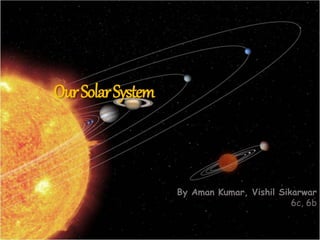
Our solar system
- 2. OurSolarSystem Our solar system is made up of: Sun Nine planets Their moons Asteroids Comets
- 3. InnerPlanets The inner four rocky planets at the center of the solar system are: Mercury Venus Earth Mars
- 4. Mercury Planet nearest the sun Second smallest planet Covered with craters Has no moons or rings About size of Earth’s moon
- 5. Venus Sister planet to Earth Has no moons or rings Hot, thick atmosphere Brightest object in sky besides sun and moon (looks like bright star) Covered with craters, volcanoes, and mountains
- 6. Earth Third planet from sun Only planet known to have life and liquid water Atmosphere composed of composed of Nitrogen (78%), Oxygen (21%), and other gases (1%).
- 7. Mars Fourth planet from sun Appears as bright reddish color in the night sky Surface features volcanoes and huge dust storms Has 2 moons: Phobos and Deimos
- 8. OuterPlanets The outer planets composed of gas are : Jupiter Saturn Uranus Neptune
- 9. Jupiter Largest planet in solar system Brightest planet in sky 60+ moons, 5 visible from Earth Strong magnetic field Giant red spot Rings have 3 parts: Halo Ring, Main Ring, Gossamer Ring
- 10. Saturn 6th planet from sun Beautiful set of rings 31 moons Largest moon, Titan, Easily visible in the night sky Voyager explored Saturn and its rings.
- 11. Uranus 7th planet from sun Has a faint ring system 27 known moons Covered with clouds Uranus sits on its side with the north and south poles sticking out the sides.
- 12. Neptune 8th planet from sun Discovered through math 7 known moons Triton largest moon Great Dark Spot thought to be a hole, similar to the hole in the ozone layer on Earth
- 13. Most of the Moon's surface is covered with regolith, a mixture of fine dust and rocky debris produced by meteor impacts. The Moon has no atmosphere. But evidence from the Clementine spacecraft suggests that there may be water ice in some deep craters near the Moon's south pole. Most rocks on the surface of the Moon seem to be between 4.6 and 3 billion years old. The gravitational forces between the Earth and the Moon cause some interesting effects. The most obvious is our ocean tides.
- 14. A meteor is a celestial event in which a number of meteors are observed to radiate, or originate, from one point in the night sky. These meteors are caused by streams of cosmic debris called meteoroids entering Earth's atmosphere at extremely high speeds on parallel trajectories. Most meteors are smaller than a grain of sand, so almost all of them disintegrate and never hit the Earth's surface. Intense or unusual meteor showers are known as meteor outbursts and meteor storms, which may produce greater than 1,000 meteors an hour. meteor
- 15. Asteroids Small bodies Believed to be left over from the beginning of the solar system billions of years ago 100,000 asteroids lie in belt between Mars and Jupiter Largest asteroids have been given names
- 16. Comets Small icy bodies Travel past the Sun Give off gas and dust as they pass
